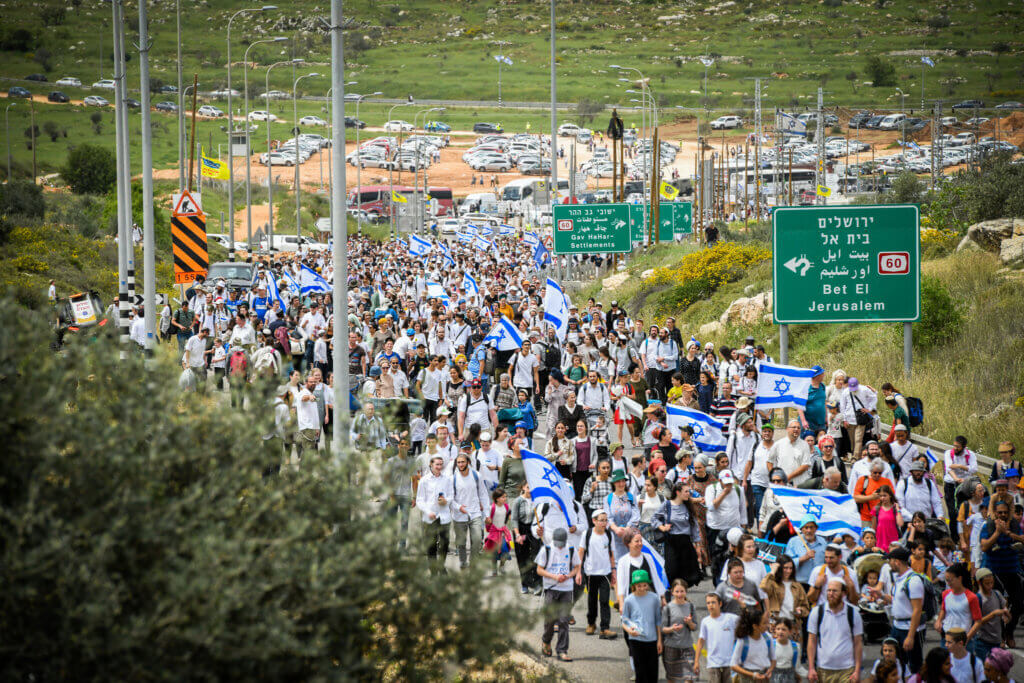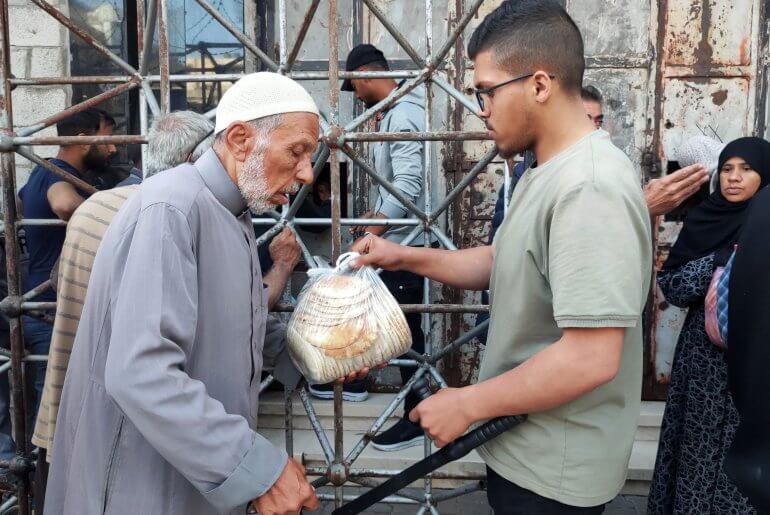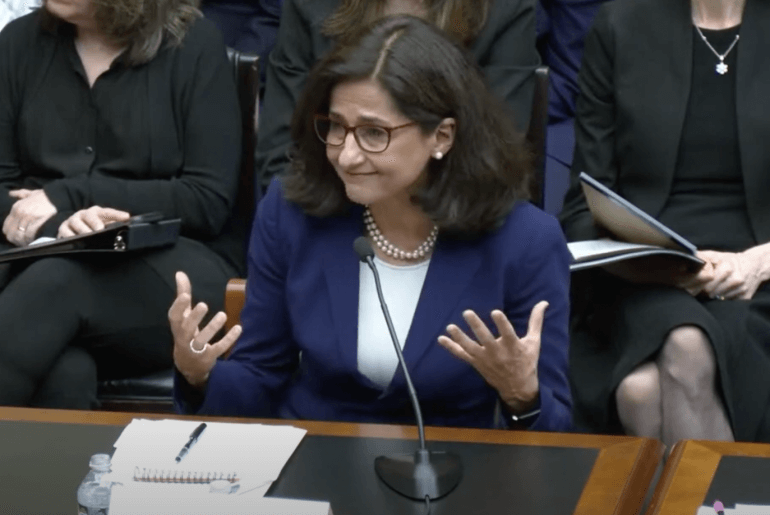Thousands of Israeli settlers took to the streets of the northern occupied West Bank district of Nablus this week in a show of power for the hard-line settler movement.
Armed with assault rifles and other weapons, the crowds of settlers – some young, some old, some entire families – waved their Israeli flags down one of the busiest highways in the West Bank, and gathered together on a Palestinian mountaintop to declare: we are here, this land belongs to us, and we want all of it.
The settler march took place on Monday, April 10, on the heels of a violent Israeli crackdown on Palestinians and Muslim worshipers at the Al-Aqsa Mosque in Jerusalem, which had threatened to set off another war and wave of uprisings akin to that of 2021.
It also came just a few days after three Israeli-British settlers were killed in a shooting operation in the northern Jordan Valley, and a number of Israelis were injured when a Palestinian driver crashed his car near a Tel Aviv beach. The same day of the march, a 15-year-old Palestinian boy was killed by Israeli forces in Jericho.
Under the rallying cry of “combating Palestinian terror,” settler leaders and Israeli government ministers marched side by side with thousands of hardline, ultranationalist settlers, to demand a proliferation of Israeli settlements in the occupied West Bank.
They called for the retroactive legalization of existing outposts – outposts that are considered illegal both under Israeli and international law – and the approval and construction of new settlements.
Israel’s National Security Minister Itamar Ben-Gvir, a hardline settler and former terror convict, described the march as a “statement – a statement that “we are here, and we are marching towards the future.”
Statement to Palestinians
The statement being made that afternoon by the settlers was no more apparent to anyone as it was to the Palestinians who were affected by the march.
Thousands of Palestinians in the Nablus area had their lives put on hold for the day as Israeli forces, who escorted the settlers on the march, enforced widespread road closures in the Nablus area. Palestinian schools were forced to close, and children were made to attend classes online.
Main roads connecting Palestinian villages, and connecting Nablus with other areas of the West Bank to its south, were shut down.
The march took place just a few kilometers away from the Palestinian town of Huwwara, where extremist settlers have been carrying out pogroms, attacking Palestinians, and setting fire to their property for the past several months.
The same ministers who called for Huwwara to be “wiped out” were present at the march.
As the settlers made their way to the Evyatar outpost, which stands on Jabal Sabih, a hilltop of privately-owned Palestinian land belonging to the villages of Beita, Qabalan, and Yatma, the Israeli army cracked down on Palestinian protesters in Beita.
According to Palestinian medics, Israeli forces fired tear gas and rubber bullets at Palestinians, injuring over 100 people.
The residents of Beita have been protesting against Evyatar since it was established in 2021, staging daily protests for months until the outpost was evacuated. Israel’s crackdown on the Beita protests has resulted in the killing of 10 Palestinians and thousands more injuries.
Aseel al-Bajeh, legal researcher and advocacy officer at Al-Haq, told Mondoweiss that the settler demonstration on Monday would have direct consequences for the safety of Palestinians on the ground.
“It’s all interconnected: the case of Beita, Qabalan, Yatma, and all other Palestinian villages that are in close proximity to settlements. They are all impacted by settler violence,” she said.
“What we’ve been seeing in Huwwara is actually well connected to the Evyatar outpost and the struggles of the Beita protests,” she said, noting that a Palestinian man who was killed during the most recent settler pogroms in Huwwara was actually from the town of Beita.
“As these villages in the Nablus governorate strive towards resisting expanding colonialism on their land, each town is being affected by various means: military checkpoints, settler bypass roads, expropriation of land, and direct settler violence,” al-Bajeh said.
In the case of Beita, al-Bajeh added the return of settlers to Evyatar can lead to more loss of life, and more life-altering injuries, as the residents of the town vow to reinvigorate the protests.
For two years, Beita’s residents have vowed they won’t stop their protests until the very last caravan [of Evyatar] is removed from their land,” she said. “The [Israeli] government knows the people in this village are not going to stop resisting.”
“They [Israel’s army] are preparing themselves to shoot to kill Palestinians- Palestinians who are mainly throwing stones against fully armed soldiers. So there is a very realistic negative impact on the lives of Palestinians There is a kind of chance in this example, a very realistic bad negative impact this will have on the lives of Palestinians.”
How Evyatar came to be
The decision to stage the settler demonstration at Evyatar was particularly provocative and was very much a part of the “clear” statement being sent by the Israeli settlers and the government.
Before understanding why the settlers chose Evyatar, it’s essential to understand the backstory of the illegal outpost.
Back in May 2021, Evyatar was set up almost overnight by settlers on top of Jabal Sabih, or Mount Sabih, on land owned by three Palestinian villages: Beita, Qabalan, and Yatma.
Unlike formal settlements, which are subsidized and approved by the Israeli government, outposts are considered “unauthorized” under Israeli law and are erected by settler groups without prior government approval. Though some outposts have been evacuated, Israel has a policy of retroactively legalizing outposts and providing military support to the settlers, which prevents Palestinians from taking back their stolen land.
For years prior to 2021, the same settler groups had been attempting to take over Jabal Sabih, but were foiled each time by popular protests launched by Palestinians.
It was in this same vein that the Palestinians in Beita launched their campaign against Evyatar, staging daily protests for nearly two months between May and July 2021. The protests were violently suppressed and claimed numerous lives, and more than 6,000 injuries, according to al-Bajeh.
Following the protests, the Israeli government, then under the leadership of former Prime Minister Nafali Bennett, decided to evacuate the settlers but said it would keep the structures of the settlement standing under the protection of the army.
Part of the agreement between the government and the settlers, which did not include nor consult the Palestinian landowners, stipulated the settlers would be allowed to “return” to the outpost once the land on the hilltop was designated as “state-owned.”
While Israel uses a variety of discriminatory laws and practices to declare Palestinian land as “state-owned” and expropriate it for settlement use, in the case of Evyatar, the government and the settlers are seeking to exploit a particular Ottoman-era law, which states that if land was not cultivated for several years, it could become the property of the state.
Despite Palestinian land-owners having the deeds to the land and having drone footage of the mountain backing up their claims that they had cultivated the land with olive trees and other crops, Israeli courts have shown no indication of ruling in favor of the Palestinians.
Rather, al-Bajeh said the courts are likely to approve the state’s plans, which will allow for the official establishment of Evyatar as a settlement.
“Declaring Palestinian land as state land is a systemic policy to colonize Palestinian land and expand the settler enterprise,” she said. “Since the 80s, the army has declared the area on the mountain as a closed military zone, preventing Palestinians from farming and accessing the land. Then they use this to argue the land is not cultivated and to hand it to the settlers.”
Why Evyatar?
So, why Evyatar? Why not other outposts, like Amona, which had previously been evacuated and served as a symbol and rallying cry for the settlers since? Or the evacuated Homesh settlement?
Firstly, Jabal Sabih is a strategic location – it sits in the heart of a cluster of Palestinian villages in the Nablus area. It also is one of the last remaining Palestinian hilltops in the Nablus district that settlers have not taken over.
If formalized, Evyatar would connect a ring of Jewish settlements around the Nablus area and cut Palestinian villages off from one another and from swaths of their land.
It’s no coincidence that Evyatar is also located just down the road from Huwwara and Palestinian villages like Burin, which face daily attacks from violent settlers who reside in the notorious Yitzhar settlement.
By choosing to stage their show of strength at Evyatar, the settlers and the government were saying loud and clear that no matter what Palestinians do, what legal avenues they pursue, or how many people are killed during protests, in the end, the settlements will prevail.
And that was at the crux of the march on Monday.
For the religious-Zionist settler movement, Evyatar is one of the biggest “successes” in recent memory. It’s why last year, the ultranationalist Nachala settler movement launched a mass outpost operation, using Evyatar as the model.
Nachala movement leader Daniella Weiss, a leader of the far-right settler movement and an advocate of an “Arab-free” Jewish state, has previously stated her movement’s goals of “establishing 10 Evyatars.”
On Monday, Weiss reiterated those goals, but this time, with the clear support and backing of the Israeli government.
“Their choice of this particular spot has many reasons. First, to send a message to the Palestinians that “we, the Israeli government, settlers, ministers, and judiciary, are working together to suppress and stop Palestinian resistance against colonial settlement expansion,” al-Bahjeh told Mondoweiss.
The presence of Israeli government ministers and members of parliament was not insignificant, al-Bajeh said. While many of the government officials present are settlers themselves and have been open advocates of increasing settlement expansion, their support on Monday constituted an important shift in how the government will be treating the settlements.
“The second message is this new government showcasing it has no shame in openly stating it wants to extend its sovereignty and control over all Palestinian land,” she continued, noting that the government recently legalized nine outposts, in violation of a recent agreement between Israel and the Palestinian Authority promising a few month pause on settlement promotion and outpost legalization.
“It is all part of the bigger, broader project to empty Palestine of its residents and replace them with more Israeli settlers.”
Yumna Patel
Yumna Patel is the Palestine News Director for Mondoweiss.




I do see a lot of flags being waved by the crowd in the image at top, but assault rifles and other weapons? I don’t see even one. Before down-voting my comment, I hope other readers will give some clues to where they see weapons in the photo.
“Were killed in a shooting operation“? What are you trying to suggest with this phrasing, instead of saying simply that the three “were shot dead”?
“Former terror convict” is a lazy description. Mondoweiss can and should do better than this! My understanding is that the terror crime that Ben-Gvir was convicted of (in an Israeli court, it should be added) was providing support to a designated terrorist organization (Kach).
And which ministers were those? Wouldn’t you want readers to know their names? Or at least signal that you haven’t forgotten their names? You do include a link to another article, but it mentions only one minister, Bezalel Smotrich, not multiple ministers, who called for Huwwara to be “wiped out.”
So these poor Jewish illegal settlers are out marching where they are surrounded by millions of heavily armed Palestinian Terrorists and they are all unarmed.
Pull the other leg.
What is it about those Jews always “storming” everywhere? Why can’t they just walk normally like the gentiles?